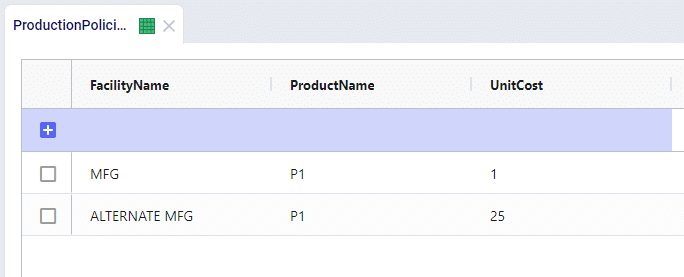

The Multi Time Period (MTP) tables allow for you to enter time-period specific data across many input tables. These MTP tables will act as overrides in the relevant periods for the records in their standard tables. If a record with the same key structure does not exist in the standard table, the MTP record won’t be recognized by the solver and will be dropped.
For example, we have a manufacturing facility with a throughput capacity of 1000 units. When this information is entered into the Facilities table, the throughput capacity will be used for each period in the model:


Let’s say that the manufacturing facility is expanding operations over the year and wants to show that the throughput capacity gradually increases over each quarter. This adjustment in throughput capacity can be defined in the Facilities Multi Time Period table:


We can see that the throughput capacity increased over time and given the constant outbound quantity, the throughput utilization goes down as the model progresses.
In all of the policy multi-time period tables, there are two fields which appear to be similar – Status and Policy Status.
For example, we have 2 manufacturing locations that can produce the same product at very different costs. We’ll see that the MFG location is used as the sole production option as it is far cheaper.


Now let’s say that we have to shut production down at the MFG location for maintenance in Q3, we can do this through the Production Policies Multi Time Period table:


This can be a quick way to to adjust policies over different times and is an alternative to using constraints. The use of Policy Status in place of constraints will stop the creation of extra solver variables as well as reducing the number of constraints being placed over the solution. This can help contribute to better model performance.
Similar to how Status and Policy Status work, you have the ability to change the operating status of a Facility and a Work Center over time. This would allow you to Open, Close, or Consider the use of a Facility or Work Center in any given period.
Using the same example as above, we can model the maintenance at MFG during Q3 by closing the entire location:


Closing the entire facility will do more than just limit production, the facility is then completely removed from the network for that given period and no other activities can take place.
The Multi Time Period (MTP) tables allow for you to enter time-period specific data across many input tables. These MTP tables will act as overrides in the relevant periods for the records in their standard tables. If a record with the same key structure does not exist in the standard table, the MTP record won’t be recognized by the solver and will be dropped.
For example, we have a manufacturing facility with a throughput capacity of 1000 units. When this information is entered into the Facilities table, the throughput capacity will be used for each period in the model:


Let’s say that the manufacturing facility is expanding operations over the year and wants to show that the throughput capacity gradually increases over each quarter. This adjustment in throughput capacity can be defined in the Facilities Multi Time Period table:


We can see that the throughput capacity increased over time and given the constant outbound quantity, the throughput utilization goes down as the model progresses.
In all of the policy multi-time period tables, there are two fields which appear to be similar – Status and Policy Status.
For example, we have 2 manufacturing locations that can produce the same product at very different costs. We’ll see that the MFG location is used as the sole production option as it is far cheaper.


Now let’s say that we have to shut production down at the MFG location for maintenance in Q3, we can do this through the Production Policies Multi Time Period table:


This can be a quick way to to adjust policies over different times and is an alternative to using constraints. The use of Policy Status in place of constraints will stop the creation of extra solver variables as well as reducing the number of constraints being placed over the solution. This can help contribute to better model performance.
Similar to how Status and Policy Status work, you have the ability to change the operating status of a Facility and a Work Center over time. This would allow you to Open, Close, or Consider the use of a Facility or Work Center in any given period.
Using the same example as above, we can model the maintenance at MFG during Q3 by closing the entire location:


Closing the entire facility will do more than just limit production, the facility is then completely removed from the network for that given period and no other activities can take place.

